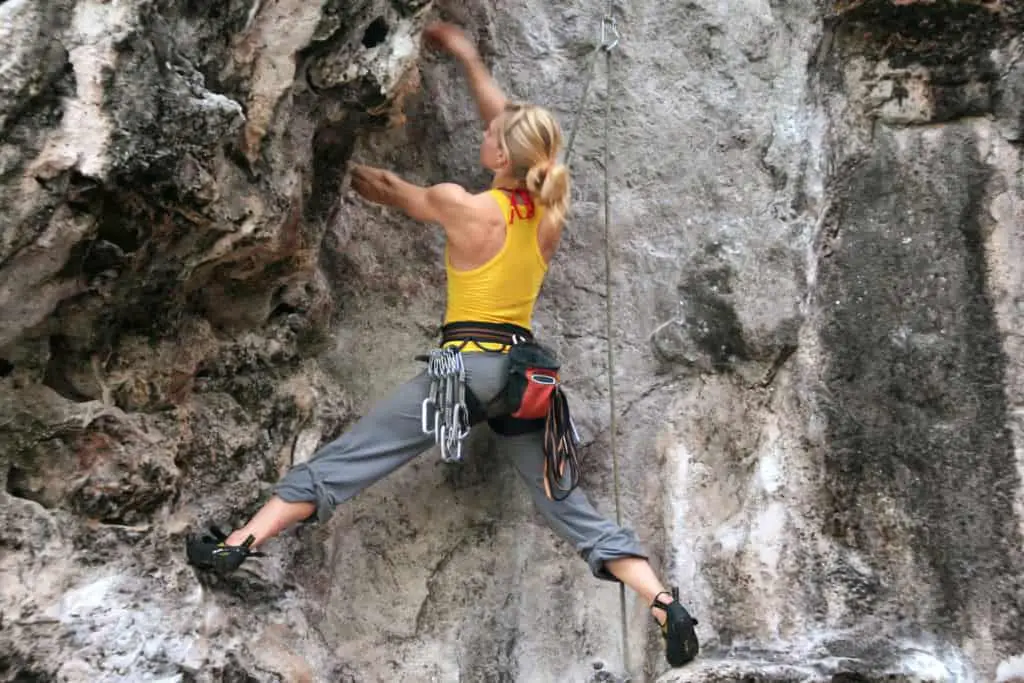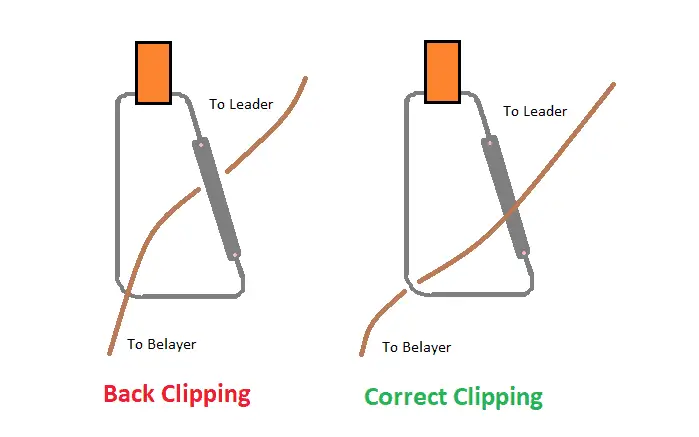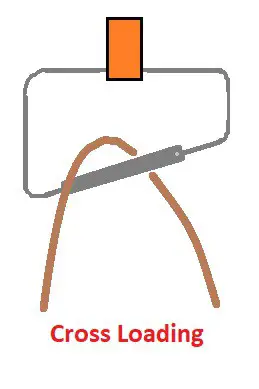
When lead climbing, the belayer feeds a rope directly up to the climber who has clipped it into their protection. This means that if the climber falls they will only fall a smallish distance and will be able to carry on climbing. Lead climbing is different to top roping because top roping already has an anchor set at the top of the climb, whereas lead climbing requires the climber to bring the rope up with them and attach it to carabiners already connected to the wall for protection. There are a few different methods of clipping that have been used – some methods have been found to be unsafe and some will actually hinder a climber’s progress up the wall.
So what is back clipping and is it safe? Back clipping is a dangerous and incorrect way of attaching your rope to a wall when lead climbing. When the rope is back clipped, it is behind the carabiner, which means there’s a chance that this can unclip the gate causing injury or death when you fall.
Let’s look at how we can avoid back clipping, other incorrect ways of clipping and how we’re supposed to clip our rope when lead climbing.
Page Jumps
- How to Avoid Back Clipping when Lead Climbing
- How to Clip a Quickdraw when Lead Climbing
- Other Ways of Clipping Incorrectly
How to Avoid Back Clipping when Lead Climbing
When clipping your rope it’s essential you use the correct technique to avoid potential injury or worse – death. When attaching the rope to your carabiner, you should clip it so that the climber’s end of the rope is away from the wall while the belayer’s side of the rope is closer to the wall. This will ensure that you carabiner does not open when you fall and therefore everything should be ok.
In a scenario where the climber has back clipped, the climber has clipped themselves on the inside of the wall and the belayer’s part of the rope is on the outside of the wall. What this creates is the potential for unclipping. As the climber climbs up they fall away from the wall and the rope runs over the gate, imitating the same way you would usually open the gate to clip the rope in, however this time it unclips the rope that’s already inside meaning that the climbing is falling a lot further than they first imagined.The problem with back clipping is that it’s an easy but dangerous thing to do and it should be avoided at all costs. If all of the rope attachments have been back clipped up the wall then the climber will fall directly to the ground assuming the carabiner gate opens.

How to Clip a Quickdraw when Lead Climbing
Learning how to clip a rope into a quickdraw if you’re lead climbing is critical in terms of safety. If you’re unfamiliar with clipping a rope into a quickdraw it can be done quite simply. You should practice clipping in before you even start climbing on the wall with a quickdraw and a rope – just imitate the scenario as if you were high up on the climbing wall.
Thumb Clipping
Thumb clipping is used when you are using your left hand and you are traversing more to the right, or your right hand and you are traversing more to the left. Place your fingers around the side of the carabiner adjacent to the gate and use your thumb to hold the rope and push open the gate. It should be that easy.
Finger Clipping
If you’re using your left hand to traverse more to the left or your right hand to traverse more to the right then you can finger clip your quickdraw. This happens by using your thumb on the side of the carabiner adjacent to the gate and using your fingers to push the rope through the gate. You can also use your middle finger to steady the carabiner and flick open the gate with your rope.
Using Your Mouth to Hold the Rope if You Need Slack
Sometimes you’ll be able to reach a bolt that’s a bit higher up than usual to clip. This generally happens when you have a good hand hold and you’re set on good foot holds so you trust yourself to stay on the wall as you reach very high up to the next bolt. In this case you’ll need more rope than usual so you’ll need to create slack. One way to do this is to hold the rope in your mouth, but beware – don’t use your teeth to hold the rope because if you fall it could rip them out or cause other kinds of damage. Instead hold the rope in between your lips, clip the quickdraw and rope in, and keep climbing.
Please note that it is best that you practice clipping with both hands and with the quickdraw facing both directions. There may be a time that you’re lead climbing and you find yourself in a stressful situation. It’s at this moment that you’ll wish you had practiced clipping from all angles and with both hands. Remember, it is crucial that you know the correct configuration in terms of what side of the carabiner the rope is clipping. Avoid back clipping at all costs!
Other Incorrect Ways of Clipping and Rope Placement
Z-Clipping
Z-clipping is named for the shape that’s made when a climber clips their rope incorrectly. Z-clipping usually occurs when two quickdraws are placed close to each other on the wall. As the climber climbs up they clip their rope into a quickdraw. They then mistakenly clip a quickdraw above with the belayer’s side of the rope rather than the climbers side. This creates a Z shape once the climber ascends. If the climber falls in this scenario, they won’t fall to the last quickdraw clipped, but instead will fall to the original quickdraw before the Z-clip happened.
To solve this problem once it’s happened you can undo the first quickdraw and re-clip it into the belayer’s side of the rope. Hopefully your belayer will notice the problem and let it known to you if it’s happened.
Cross Loading
Cross loading occurs when it is clipped incorrectly – the rope has been loaded onto the carabiner gate and therefore puts pressure onto it making it weaker which means it may end up breaking. This usually ends up happening when the rope-end carabiner has a defect on the rubber that’s designed to stop the carabiner from moving out of position. You should always check your quickdraws to make sure they are still working properly. The edge of a rock can also cause cross loading. This happens when the quickdraw gate presses down onto the edge of the rock and opens it.

Sticky Gates
Quickdraw gates can sometimes stick due to cheap and/or defective equipment. When a gate sticks it may not close and therefore the rope can exit from the quickdraw. If the climber falls they’ll fall further than expected.
Quickdraw Direction Placement
Quickdraws should be placed facing a certain way if you are traversing as you make your way to the next bolt. For example, if you are traversing to the left, the gate on your quickdraw should be on the right side so that rope does not push onto the gate as you climb or fall. There is only a small chance that this will cause a problem, however it’s best to reduce any hazards if possible.
Positioning the Rope Incorrectly
When lead climbing you should always make sure that the rope is not running under your legs and is instead running to the side of them. If the rope is running under the legs it can cause you to turn upside down and/or receive rope-burn on the inside of your legs if you fall. Turning upside down when falling is quite dangerous because it can cause you to hit your head on the wall with great force. Remember to wear a helmet at all times when lead climbing.
